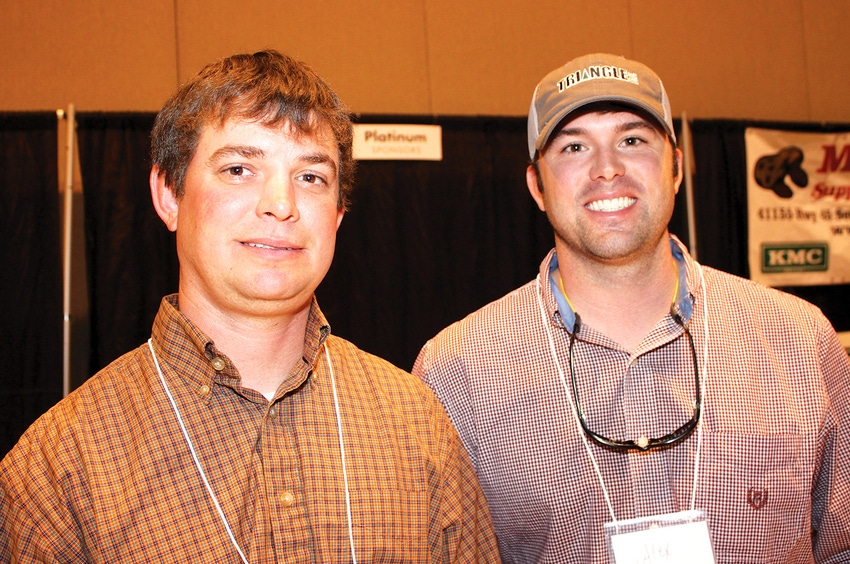
"Little land mines produced by southern blight can lay in the soil for years, and when a peanut plant grows close enough, they germinate, run their little fingers out, get hold of the plant, and start to chow away," says Alan Henn. Uncontrolled, the disease can take a toll on peanut yield.

"Little land mines” produced by southern blight can take a bite out of peanut yields, and Mississippi growers need to be aware of how to find the disease and how to deal with it, says Alan Henn.

ALAN HENN
“It’s also important to know how to distinguish it from true white mold, because the fungicides you use for white mold don’t work on southern blight,” he said at the annual meeting of the Mississippi Peanut Growers Association.
“You need to make a clear distinction between the diseases, because it can make a direct difference to your pocketbook.”
Henn, who is Mississippi State University professor of entomology and plant pathology, says southern blight produces “tiny balls of fluff that harden into sclerotia and drop off the peanut stem.
“They act like little land mines — they can lay in the soil for years, and when a peanut plant grows close enough, they germinate, run their little fingers out, get hold of the plant, and start to chow away. Some may explode almost overnight, producing fluffy-looking mycelia.”
Stay current on what’s happening in Mid-South agriculture: Subscribe to Delta Farm Press Daily.
The mycelia have a whitish color, he says, while true white mold mycelia have a charcoal color. “That’s one way to distinguish them,” he says.
Most southern blight germinates slowly, “and you see it on top of the soil, spreading ropy-like mycelia, extending around and strangling the plant, dissolving the outside tissues.”
In 2014, however, Henn says, in the Delta, on heavier soils, there were instances “where there were no symptoms on top of the ground. But if we took a shovel and dug plants, we found mycelia growing on peanuts under the soil, causing decay. It wasn’t until much later that the plants themselves started to exhibit symptoms of the disease. The only way we knew it was there was by digging up plants.
“Fortunately, we caught it early on, got the news out, and producers were able to take action to deal with it.”
ORDER YOUR 2015 DELTA AGRICULTURAL DIGEST NOW!
The new Delta Agricultural Digest will soon be available. Place your order today and we’ll ship yours as soon as they’re printed. Phone 800-253-3160, Extension 70125 to order.
In such a situation, Henn says, drenching fungicide applications are recommended.
“Remember, when doing this, that peanuts fold their leaves at night. You want to apply the fungicide at night with a lot of water — at least 20 gallons per acre — and drench it into the soil. Don’t apply it when leaves are opened out, because that doesn’t do much good; you need to get it down into the soil. Growers who had this problem and made applications were able to get the situation under control and they had a good crop.
Keeps spreading unless stopped
“It’s possible to manage this disease, but you need to actively be looking for it and then take action.”
A FUNGICIDE application near the time vines touch in row middles almost always reduces damage by southern blight, says Alan Henn.
If left untreated, Henn says, “by the end of the season it can have spread up and down the row, killing plants, and costing you a lot of yield. It just keeps spreading, unless you stop it.”
There is a linear relationship between the number of plants that are damaged and reduction in yield, he says.
In his tests, he used seven different fungicides, applying them at 20 gallons per acre at 33 psi, two nozzles per row to make sure the fungicide was getting to the base of the plant where the fungus was germinating — “providing a collar of protection against the disease.”
REGISTER NOW FOR MID-SOUTH AG/ENVIRONMENTAL LAW CONFERENCE
Applications were at 100 percent emergence, 20 days after 100 percent emergence, and 40 days after 100 percent emergence. Combined data from 2013 and 2014 showed the 40 days after 100 percent emergence timing to be the most effective. “The fungicides made a significant difference in the number of hits by the disease.”
The trials were in fields that had a known risk for southern blight, Henn notes. “Will this treatment pay off if your field doesn’t have a strong history of the disease? Maybe, maybe not — we can’t say definitely. But if you do have a history of southern blight, you may want to consider an application 40 days after 100 percent emergence.
“That is about the time vines are just about meeting in the center of the rows — about the last time you can get through the field and apply a fungicide to the base of the plants. An application near vine touch almost always reduces damage at harvest.”
Incidence of the disease varies year to year, Henn says. “This year, there may be none, there may be a lot, or it may be totally random. The conditions of a particular year strongly affect the disease incidence.”
Rotation continues to be important in reducing peanut diseases, he says.
“We’re seeing more leaf spots overwintering, and they can cause big yield reductions. You need to keep rotations as long as you can. When you ignore rotations, you’re hurting not only yourself, but your neighbors also.
“In one case of early leaf spot last year, I was able to trace the origin of the to a location 14 miles from the infected field. It had moved with a storm. So, what you do can directly affect your neighbors, and even farms some distance away.”
Rotations can also keep out “diseases we don’t have here, and don’t want here. One that’s really, really nasty, is Cylindrocladium black rot — it’s called red crown rot in soybeans. We don’t want this one.”
YOU MIGHT ALSO LIKE THESE PEANUT GROWER STORIES
Hugh Pierce: Peanuts pay the bills in rotation with cotton
Joe Morgan: Peanut/cotton/corn rotation ‘has been good for us’
Rotation can boost yields, Henn says, while lack of rotation can bring disease buildups and lower yields. “Do yourself a favor, and do your neighbors a favor, and keep your rotations just as long as you possibly can.”
About the Author(s)
You May Also Like



